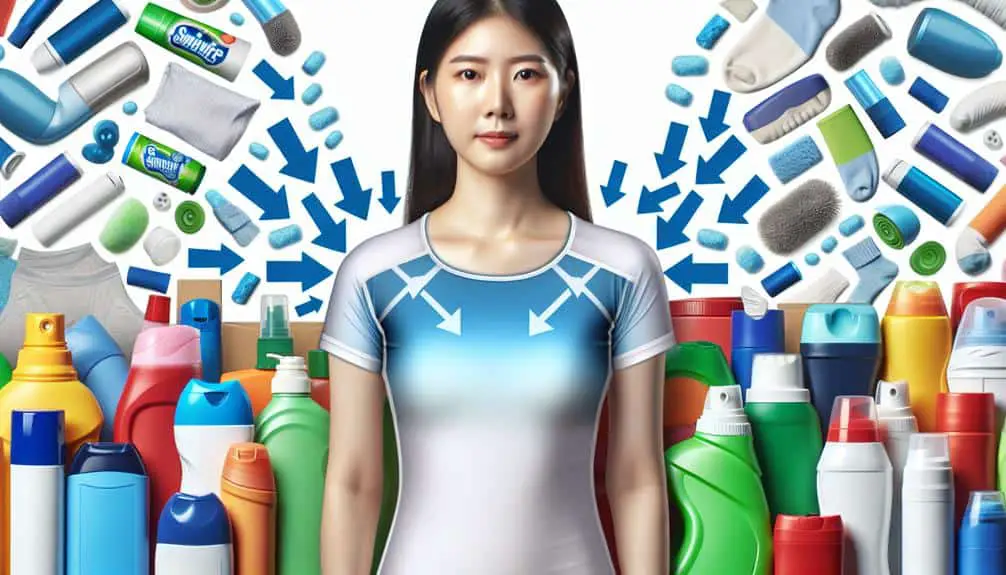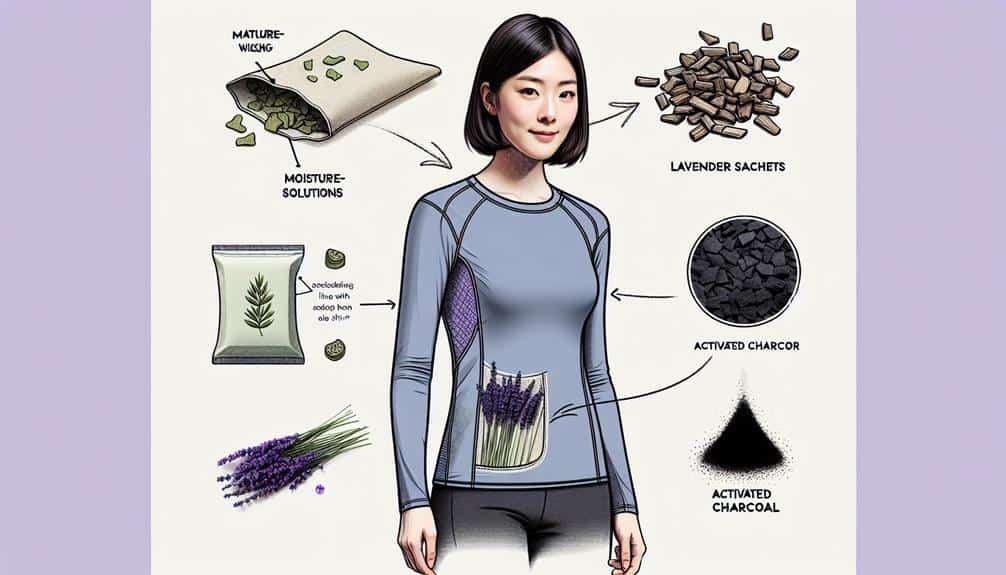Mastering odor-free moisture-wicking shirts involves five key secrets. Control microbial growth by choosing antibacterial fabrics. Understand sweat's role in bacterial proliferation for odor prevention. Opt for fabrics like polyester, nylon, or merino wool for effective moisture management. Consider antimicrobial treatments to combat bacteria and maintain freshness. Maintain shirts properly by washing in cold water with gentle detergent and avoiding fabric softeners. Follow drying guidelines for prolonged shirt performance. Perfecting these secrets will transform your shirt experience.
Key Points
- Choose moisture-wicking shirts with antimicrobial treatments.
- Wash shirts in cold water with gentle detergent.
- Avoid fabric softeners to maintain moisture-wicking properties.
- Properly dry shirts to preserve shape and performance.
- Opt for fabrics like polyester, nylon, or merino wool for optimal odor control.
The Role of Microbial Growth
Microbial growth plays a critical role in the development of odors in moisture-wicking shirts. These garments create an ideal environment for microbial proliferation due to their moisture-absorbing properties. When sweat is absorbed by the fabric, it provides a nutrient-rich medium for bacteria to thrive. As these bacteria break down the sweat components, they release volatile compounds that lead to unpleasant odors.
To combat this issue, effective microbial control is essential for odor prevention in moisture-wicking shirts. One common approach is the integration of antimicrobial agents into the fabric. These agents work by inhibiting the growth of odor-causing bacteria, thereby reducing the likelihood of odor development. Additionally, proper laundering practices, such as washing the shirts at the recommended temperature with antimicrobial detergents, can further aid in microbial control.
Understanding Sweat and Bacteria
Sweat serves as a key factor in the interaction between moisture-wicking shirts and bacteria, influencing the development of odors within the fabric. Understanding the dynamics of sweat absorption is vital in the battle against bacterial growth and subsequent odor formation. Moisture-wicking shirts are designed to pull sweat away from your skin and disperse it across the fabric, allowing for quicker evaporation. This process helps in reducing the amount of moisture that bacteria thrive in, thereby decreasing the likelihood of odor development.
Moreover, effective bacteria prevention is essential for maintaining odor-free moisture-wicking shirts. Bacteria naturally present on your skin can multiply in damp environments, leading to unpleasant smells. By choosing moisture-wicking shirts with antibacterial properties or using specialized detergents that target odor-causing bacteria, you can actively combat microbial growth. Additionally, ensuring proper ventilation and allowing your shirts to dry thoroughly between uses can further aid in preventing bacterial proliferation and the subsequent formation of odors.
Understanding the relationship between sweat, bacteria, and moisture-wicking shirts is key to keeping your activewear fresh and odor-free.
Importance of Fabric Composition
Understanding the fabric composition is essential for maximizing the performance and odor-fighting capabilities of moisture-wicking shirts. Fabric technology plays a vital role in determining how well a shirt can wick moisture away from your skin and prevent odors from developing.
Fabrics like polyester, nylon, and merino wool are commonly used due to their moisture-wicking properties. Polyester is excellent at moisture management and dries quickly, making it a popular choice for athletic wear. Nylon is durable and provides good ventilation. Merino wool is known for its natural odor control abilities, making it a great option for those seeking a more eco-friendly choice. These fabrics are often combined or blended to enhance their properties further.
Understanding the fabric composition allows you to choose a shirt that aligns with your needs, whether it be intense workouts or everyday wear, ensuring maximum comfort and odor control.
Benefits of Antimicrobial Treatments
Utilizing antimicrobial treatments in moisture-wicking shirts can greatly enhance their odor-fighting capabilities and overall performance. These treatments work by inhibiting the growth of odor-causing bacteria, thereby helping to keep your shirt smelling fresh even during strenuous activities. The antimicrobial properties prevent the bacteria from breaking down sweat and producing unpleasant odors, providing effective odor control.
In addition to odor control, antimicrobial treatments offer longevity benefits to moisture-wicking shirts. By preventing bacterial growth, these treatments can help extend the lifespan of the shirt by reducing the likelihood of fabric deterioration caused by microbial activity. This means that your moisture-wicking shirt can maintain its performance and freshness for a longer period, ensuring that you get the most out of your active wear investment.
Proper Care and Maintenance
To maintain the peak performance and longevity of your moisture-wicking shirt, it's vital to follow specific care and maintenance guidelines tailored to the fabric composition and construction of the garment. When washing your moisture-wicking shirt, it's important to use cold water and a gentle detergent. Avoid using fabric softeners as they can leave residues that clog the fabric's pores, reducing its moisture-wicking ability. Turn the shirt inside out before washing to protect the outer surface and prevent pilling. Additionally, consider washing similar fabrics together to prevent abrasion damage during the washing cycle.
For drying techniques, air drying is the most gentle option for moisture-wicking shirts. If you prefer machine drying, use a low heat setting to prevent damage to the fabric fibers. Remove the shirt promptly once dry to prevent wrinkles and maintain its shape. Avoid hanging the shirt in direct sunlight for extended periods as this can cause colors to fade.
Frequently Asked Questions
Can Moisture-Wicking Shirts Help With Body Odor Caused by Hormonal Changes or Medical Conditions?
Like a skilled detective sorting clues, you need moisture-wicking shirts for body odor from hormonal changes. They may not fully combat odors tied to medical conditions, but they excel in managing sweat for better comfort.
Are There Any Potential Health Risks Associated With Wearing Moisture-Wicking Shirts for Extended Periods of Time?
Wearing moisture-wicking shirts for extended periods poses potential risks like skin irritation due to prolonged contact with sweat and bacteria. Assess breathability and opt for quality fabrics to reduce these impacts on your skin.
How Do Moisture-Wicking Shirts Compare to Traditional Cotton Shirts in Terms of Odor Control?
When comparing fabric types for odor control, moisture-wicking shirts outperform traditional cotton due to their superior sweat management. These shirts offer enhanced performance benefits, keeping you dry and odor-free during extended wear.
Do Moisture-Wicking Shirts Lose Their Effectiveness Over Time With Repeated Washings?
With proper fabric care and suitable drying techniques, moisture-wicking shirts can preserve their effectiveness and longevity despite repeated washings. Consistent maintenance guarantees that the shirts retain their moisture-wicking properties over time.
Are There Any Natural Remedies or DIY Solutions to Reduce Odor in Moisture-Wicking Shirts?
You've delved into the world of natural remedies and DIY solutions for addressing the persistent odor that plagues your moisture-wicking shirts. Harness the power of baking soda or vinegar to neutralize those pesky smells.



